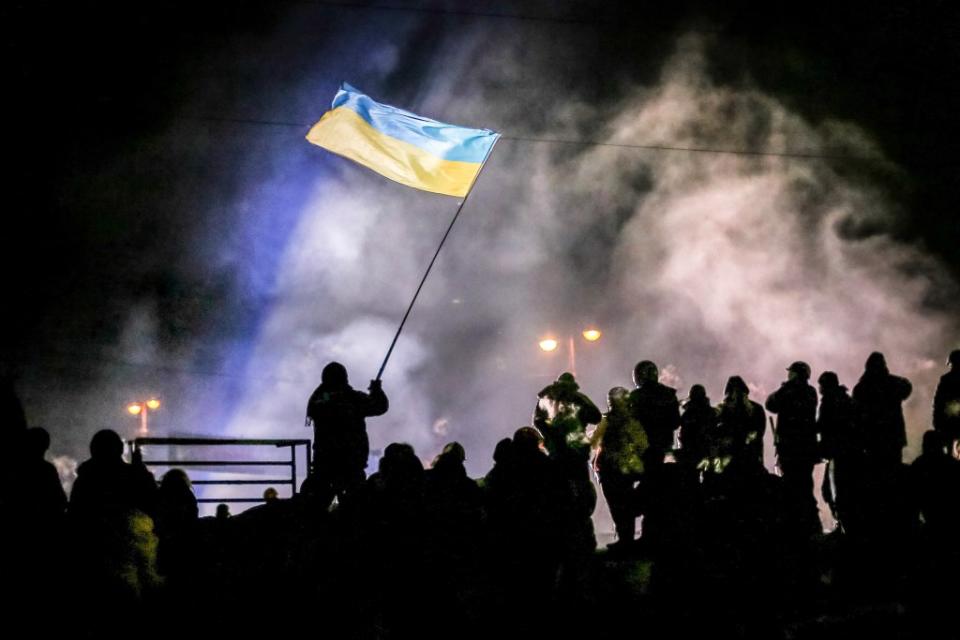‘Winter on Fire’: The Evolution of Ukraine’s Revolution
Gunshots and screams ring out. “Do something. Do something for the revolution” a man says above the sound of more gunfire. Protesters wearing hardhats and carrying makeshift metal shields are clamoring in the streets, directing each other to avoid sniper fire. A young man stops and turns to the camera to describe how he just dragged a dead body from the street as even more shots echo in the background.
“You thought it would be easy, just go to Maidan, hang out a little and then go back?” the young man says. “Not me.”
The powerful scene is from the last days of the protests known to most of the world as the Maidan, or otherwise known as the Revolution of Dignity in Kiev, that ousted former Ukrainian President Viktor Yanukovych. It’s the starting point for Winter on Fire: Ukraine’s Fight for Freedom, a moving — and at times graphic — documentary that catalogues the 93 days of the protest movement from its early days in November 2013 to its zenith in February 2014. In anticipation of the film’s Friday release on Netflix, Foreign Policy sat down with Evgeny Afineevsky, the film’s Soviet-born American director, during a visit to Washington last week.
“I wanted to show the human story behind the headlines,” Afineevsky told FP. “We never knew what would happen next. We just came to capture events as they unfolded. It was all very organic.”
Winter on Fire is not an exhaustive history of the Ukraine crisis, but is instead meant to be an on-the-ground account of the protests and the people who fought — and at times died — on the streets. Rather than focus on the sweeping political maneuvers underway in Ukraine or the jostling between Yanukovych, the European Union, and Russia, Afineevsky decided to tell the story of those who came out on the streets and does so with visually stunning and emotionally gripping footage that takes the viewer deep inside the anatomy of the protests.
When Afineevsky and his team of filmmakers came to the Ukrainian capital in the fall of 2013 to Kiev’s Maidan Nezalezhnosti (Ukrainian for Independence Square), they weren’t exactly sure what they had found. Yanukovych had just backpedalled on signing an association agreement with the EU and the protests were mostly just students camped out.
“At first it was more festival than protest. People just wanted to be heard,” said Afineevsky. “In those early days, nobody was expecting kids being killed or kidnapped in the middle of the night. That surprised lots of people.”
What followed were the iconic scenes that gripped the world and redrew the geopolitical lines in Europe. On Dec. 11, 2013, riot police known as the “Berkut” tried to clear people from the square. Afineevsky’s team vividly captures this clash, with lines of young protesters with their arms locked together struck with batons and dragged away bleeding. As the clashes escalated throughout the night, word spread throughout the city and thousands of new protesters flocked into the square.
“I will always remember that moment, everyone was united. It was when I knew history was happening,” Afineevsky said.
At its height, Winter on Fire shows the evolution of a revolution, from student protest to mass movement, while conveying the hopes and dreams those who camped out for months in the freezing cold. Yet Afineevsky’s story is but a snapshot of Ukraine’s full story. Everyday Ukrainians came to protest against the corruption and poor governance that had plagued the country in its 24 years of independence. But the fallout from Maidan — the annexation of Crimea, the war in eastern Ukraine, and the struggle to transition away from the old system of oligarchs and backroom deals — has been equally transformative, and in some cases, detrimental, for Ukraine.
“The movie I made was only one chapter of Ukraine’s history. The story is still unfolding,” said Afineevsky. “But it should be a reminder to all governments, even the current one in Kiev, that this is what happens when you ignore your people.”
Photo credit: Netflix/ “Winter on Fire”






